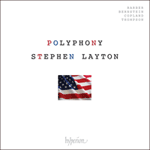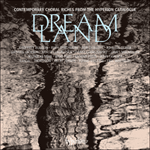
Welcome to Hyperion Records, an independent British classical label devoted to presenting high-quality recordings of music of all styles and from all periods from the twelfth century to the twenty-first.
Hyperion offers both CDs, and downloads in a number of formats. The site is also available in several languages.
Please use the dropdown buttons to set your preferred options, or use the checkbox to accept the defaults.

| Polyphony, Stephen Layton (conductor)» More |
One clearly hears in this score Thompson’s expert writing for voices, his fondness for and deft use of sequences, suspensions and counterpoint combined with his ability to control the overall pacing and structural scheme of the composition. The Alleluia is tightly constructed and moves very carefully and strategically—through the use of dynamics, articulation, expanded range, harmonic rhythm and accelerating tempo—to the very high point of intensity near the end of the work, before receding from its gorgeous wave of choral sound to return once again to its introspective beginning. The Alleluia has become a beloved and time-honored contribution to the choral repertoire.
from notes by Morten Lauridsen © 2008
 American Polyphony American PolyphonyChoral treasures from Samuel Barber, Leonard Bernstein, Aaron Copland and Randall Thompson.» More |
 Dreamland DreamlandThis sampler disc seeks to give a flavour of the contemporary choral music recorded by Hyperion over the last decade. Whilst on one level it can stand alone as a tribute to the beauty of its composers’ writing and choirs’ singing, it also lifts th ...» More |

